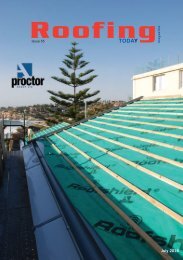Roofing
2kZ2j9o
2kZ2j9o
Create successful ePaper yourself
Turn your PDF publications into a flip-book with our unique Google optimized e-Paper software.
Rooflights<br />
How Rooflight Area Affects Light Levels, Energy Costs and CO 2<br />
Emissions<br />
NARM’s Technical Committee, explains how small differences in rooflight area can have a significant impact on light levels and energy usage.<br />
It is now well understood that correctly specified rooflights<br />
save energy and reduce CO 2 emissions, making them a critical<br />
contributor to meeting Part L of The Building Regulations<br />
covering the Con-servation of Fuel & Power and the equivalent<br />
regional regulations.<br />
Independent research by the De Montfort University’s Institute<br />
of Energy and Sustainable Devel-opment has shown that<br />
minimal losses in thermal insulation are greatly offset by energy<br />
savings resulting from reduced demand for electric lighting and<br />
that generally speaking, the greater the rooflight area the<br />
greater the potential savings. However, there is a limit before<br />
overheating may become an issue, so an optimum area needs<br />
to be identified.<br />
There is never a specific solution in respect of rooflight area –<br />
judgement is required on a project-by-project basis. However,<br />
the example shown below, demonstrates how data can be<br />
interpreted to inform a decision. NARM can supply data for<br />
different building locations, for rooflights with vary-ing degrees<br />
of light transmission and for different daily time windows.<br />
The first consideration in establishing rooflight area, is the use<br />
of the building. As a typical example, in retail and<br />
manufacturing areas, the recommended light level is 500 Lux<br />
(as listed in CIBSE Guide A).<br />
Establishing the appropriate rooflight area to achieve the<br />
desired light level is the next point to consider. The larger the<br />
rooflight area, the more hours each year the required light level<br />
will be provided by natural light. This is the crucial factor<br />
affecting energy and emissions reductions – as during these<br />
hours, the need for electric lighting is removed.<br />
This graph shows how rooflight areas will affect illumination<br />
levels. In this example - for a single storey building located in London, between the<br />
hours of 6am and 6pm daily, with rooflights provid-ing 50% light transmission - you<br />
can see that as the rooflight area along the bottom of the graph in-creases, the length<br />
of time a given illumination level is achieved, is extended.<br />
So, for a building requiring 500 lux, looking at the yellow line, you can see that with<br />
10% rooflights, 500 lux would be achieved for approximately 2000 hours or 46% of the<br />
working year.<br />
If the rooflight area is increased to 15%, 500 lux is then available for just over 2500<br />
hours, or 58% of the working year. So a building with 10% rooflights will require<br />
electric lights to be turned on for approximately 30% more hours per year than if the<br />
building was fitted with 15% rooflights.<br />
Automatic Controls<br />
It’s important to note that the savings will only be made if the lights are switched off<br />
during periods when they are not required and for this reason automatic lighting<br />
controls should always be speci-fied as part of the project.<br />
Recent research carried out by Elmhurst Energy supports these figures and gives<br />
detailed savings in building running costs resulting from improving daylight levels<br />
and installing lighting controls in existing buildings. The results show savings in<br />
running costs of up to £5.92/m 2 /yr, and savings of CO 2 emissions up to 28.7kg<br />
CO 2 /m 2 /yr can be achieved, with results from industrial and retail buildings being<br />
very consistent. Slightly lower savings were achieved in the rooflit areas of a school<br />
(savings in running costs of £2.92/m 2 /yr, and savings of CO 2 emissions of<br />
14.7kg CO 2 /m 2 /yr) pri-marily because significant sections of the rooflit areas<br />
were also well lit by windows, reducing the effect of improved illumination<br />
through rooflights.<br />
These figures demonstrate that correctly specified rooflights will provide an<br />
outstanding long-term return on investment with short payback periods – as<br />
well as contributing to improved sustainability credentials for the building<br />
occupier.<br />
For a deeper insight into energy saving with rooflights, the following<br />
documents can be downloaded free of charge from www.narm.org.uk:<br />
NARM Technical Document NTD 06.2 ‘Designing with Rooflights Supporting<br />
Part L Building Regulation’<br />
NARM Technical Document NTD 10 “An independent report by Elmhurst<br />
Energy, on Improving Daylighting and Lighting Controls on existing<br />
non-domestic buildings’.<br />
Call 01483 271371 or<br />
email<br />
sales@whitesales.co.uk for<br />
more information.<br />
www.whitesales.co.uk<br />
Enquiry 56<br />
Enquiry 40<br />
Page 12 <strong>Roofing</strong> Today




